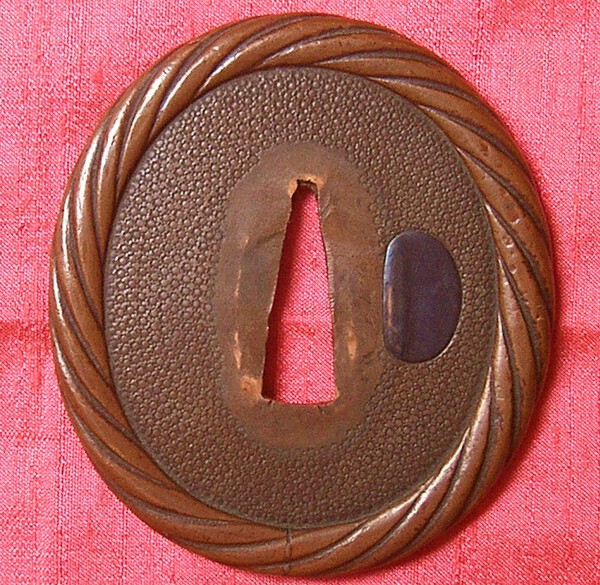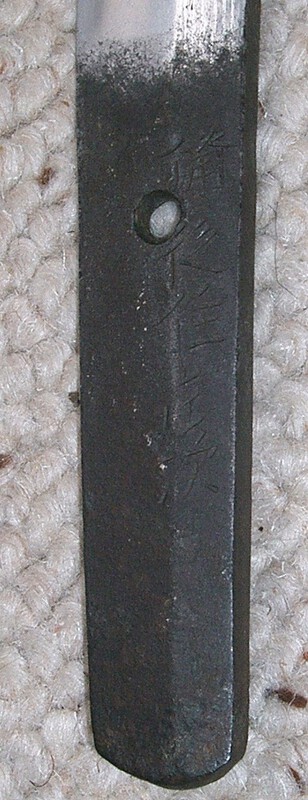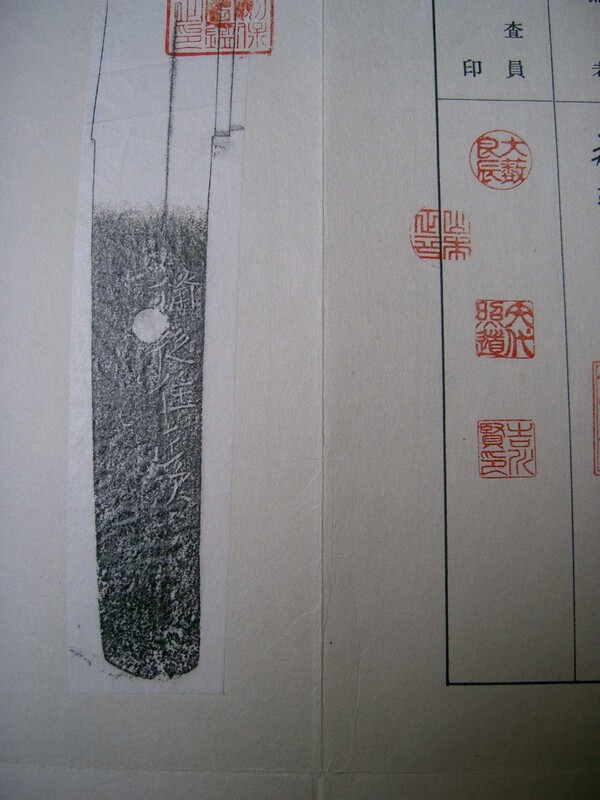
Geraint
Members-
Posts
3,080 -
Joined
-
Last visited
-
Days Won
9
Content Type
Profiles
Forums
Events
Store
Downloads
Gallery
Everything posted by Geraint
-
My Japanese Sword New Polish Wakizashi Stout Naginata Naoshi
Geraint replied to bmoore1322's topic in Nihonto
Thanks Jean, had a coffee before replying and didn't refresh the page. Nice to see another Lensman reader by the way. -
My Japanese Sword New Polish Wakizashi Stout Naginata Naoshi
Geraint replied to bmoore1322's topic in Nihonto
Looking good Brian. Very surprised to see your blade described as unokubi zukuri though. (Already covered I see, posts crossing.) No one has answered your question about the value in relation to the mon. I think unless you have a documented connection with a daimyo family then the use of a mon is not significant, unless the koshirae is of startlingly high quality. (Again, already covered, ah well!) Enjoy! -
Touche! Just goes to show how similar they are. Either that or eyesight failing.
-
I'm sure you have heard the one about impulsive samurai tying the sword to the saya with a piece of paper string...............? Guessing as I am sure you can tell.
-
Brian, I think you are right in this regard, the images of the overall view of the first two swords in their shirasaya are identical; it's the same picture. Case of image confusion on the part of the seller I suppose. Cheers
-
Japanese Wakizashi Samurai Sword
Geraint replied to cameoking's topic in Auctions and Online Sales or Sellers
No problem, Jean. -
http://www.yamabushiantiques.com/KABUTO28.htm Same one?
-
please help in translation item up for bid
Geraint replied to cameoking's topic in Translation Assistance
Hi Alex. Tosogu = collective noun for sword fittings. Jean was suggesting that they were the ones to help you. The translation is given on the Ebay description, the tsuba is to my eye nice and of course it has papers so you can have some confidence. The question is, do you like it? Enough to spend money on? If the answer to those two questions is, "Yes!" then away you go. You might also find something to your taste here, http://www.silk-road.us/iron.html Have fun! -
Would love to say I had one but... illustrated in R and P Knutsen, Fig 29, "An unusual tsukushi - uekama - jumonji- yari. Another in Bottomely and Hopson, page 148. Not a modern make up or a later conversion but a nice piece. Cheers
-
Hi All. The images below are of two tsuba, one is copper, 75mm x 68mm x 7 at the mimi. The plate bears a stamped pattern, the single hitsu ana is plugged with shakudo and the applied rim is roped. The other face is identical but bears heavy punch marks to adjust the nakago ana. The second is solid, blue - black shakudo, much better in hand than in the image, 72mm x 68mm x 5mm, slight fullness near the nakago ana tapering just a littel towards the mimi, the surface worked with very regular and well formed grooves, the mimi similarly decorated with grooves running around the circumference. I have come across a similar example for tsuba 1 but nothing like tsuba 2. Both are on swords with complimentary koshirae. I would love to know your thoughts on these. Many thanks.
-
Couldn't agree more that the maker should take his bow but not so sure about the bending of the staves. Looking at the ones either side of the ones with the kanji the grain reversal would indicate the cutting from solid rather than a bend , don't you think? Imagine a piece of timber with a valley carved into it at that point, pretty much what we are seeing here I think. Just goes to show we can manage to create a debate about almost anything here! Cheers
-
Socket (Fukuro) Yari from Showa22
Geraint replied to Brian's topic in Auctions and Online Sales or Sellers
Ah Brian, I feel your pain. My father once said to me that I had excellent taste but that it was a pity that I would be unlikely ever to have the means to support it. I can understand why you liked this one so much. -
MIHARA MASATSUGU from the Koto Period 1550 I just bought
Geraint replied to bmoore1322's topic in Nihonto
Well Brian, I think it is a nice sword and you will be able to learn a lot by studying it. Even if the school does not rank very high the blade looks very nice and I am sure you will enjoy it. All the best. -
And just to pour oil on troubled waters or fat on the fire, Red Cross Catalogue, number 884. "Sano. The founder, Naoyoshi, was a Yanagawa pupil, the following pieces however have been selected to show the style of sumizogan on gold under nanako which originated with that school. (884 being illustrated).......the nanako being punched all over the surface after inlaying the gold." That nanako is capable of being carried out over an inlayed surface is not a problem, the key or undercutting of the inlay being deeper than the nanako. Weather this is the technique applied to the kodzuka that started the discussion is a moot point. Some years ago Ford showed me a small piece of nunome zogan that was so fine it resembled morning mist so I suppose the idea of punching foil over a shakudo base is possible but certainly the hard way to do the job. I really must get a hobby, no, wait this is a hobby!
-
For what it's worth, "Among the many Yanagawa offshoots the most famous are the Sano (inlay covered with nanako giving the effect of brocade." Robinson.
-
Franco, Lee. Try the link I gave, go to full screen on the kodzuka and zoom in. I think you will see the irregularity you are looking for. Given fine nanako you would achieve the same effect as a low resolution digital image. I have seen it referred to as an attempt to create the impression of brocade as Ian says. Logical way to do it would be inlay first, honzogan I suspect and then nanako. The tsuba I was thinking of is in Robinson, "Arts of the Japanese Sword", plate 4. A tsuba with an inlaid butterfly given this treatment, signed, Wada Isshin Masatatsu according to the caption.
-
And without you guys and the NMB how many of us would have made the same mistake, only to discover much later that we had been fooled. Discovery learning is a powerful tool, but for those of us who have learned from this thread, a big Thank You! That goes for those who answered the questions and those who asked.
-
Hi Ron. Nice kodzuka and a technique that does crop up from time to time. Have a look at the ground on the kodzuka on this one; http://www.garthvincent.com/antique/837 ... ed+tanto+/ I have a feeling that I have seen a tsuba with a similar technique in the collection of the V and A museum, I'll see if I can find it.
-
Great results Matt, I would never have thought it possible. Just an idea, rather than emery paper have you tried a fibreglass pen? Roy swears by it. Principle being that it gets at the rust but not the base metal.
-
Translation - confirmation help please.
Geraint replied to Sam Elliott's topic in Translation Assistance
Hi Sam. Would love to see some pictures of the sword, always interested in Inshu Kanesaki swords. All the best. -
Hi Joe. Interesting question. At the simplest level it depends if you own Kanabo sword or not. Non owners will subscribe to the accepted judgement which is that they were made in a period when there was a sense of urgency about making swords and are therefore not the finest; comments about coarse hada and the sugata evidence this. Owners will more likely describe them as undervalued and point out the virtues of a sword appreciated by the Samurai for their cutting ability and battle worthiness. You will have done the search and found out the history of the school and you will probably have noticed that there are a number for sale, some at quite steep prices. The bigger question is how you want to collect. As a practitioner of sword arts you might well feel that swords valued by Samurai as good weapons have an interest for you, in which case swords which are described as functional rather than artistic will appeal; Kanabo and Takada blades for example. There will be those who will advise against this because there is another view which is that you should aspire to the best and these schools are not it. There are several articles about how people collect relevant section of the board, However I have to admit that I have seen several Kanabo blades that I would be very happy to have owned, if you like one then buy it. Have fun!
-
MIHARA MASATSUGU from the Koto Period 1550 I just bought
Geraint replied to bmoore1322's topic in Nihonto
Here you go. Mine has quite an active hamon underneath the hadori, midare based on suguha might describe it. Hope this is of interest. -
MIHARA MASATSUGU from the Koto Period 1550 I just bought
Geraint replied to bmoore1322's topic in Nihonto
Hi Brian. For what it's worth I like the sword, probably because I have one like it. Hawley only lists one smith signing this way and gives a typical date of 1503 while this link, http://www.sho-shin.com/sanyo19.htm should take you to a lineage which has him working typically around 1501. I don't think it matters who owned the sword rather what matters is the smith who forged it and the sword itself. If I get a chance I will do some images of mine and the NTHK paper with it for comparison for you. Enjoy. -
Hi Grev. I see no one has embarked on a reply so from my limited knowledge here goes. First, none of the tsuba are anything other than what they seem, Japanese and none as far as I can see are cast so you have genuine tsuba. There are quite a lot of tsuba around which are fine for mounting on a sword, which after all is what they were intended for, but perhaps not collectable in their own right. The condition is far from perfect, some better than others. For what it's worth here are my thoughts; 1 Wakizashi size? The horse looks rather nice and although we only have one face to go on this would look good with a little care and time. 2 Not a great deal to say here, is this the more interesting face? Again it's had a hard life and may look bettre after some TLC. 3 The carving of the tree is nice, not sure what the floral bit in soft metal is. 4 A pleasant tsuba of a fairly common theme, the work seems quite good. 5 I am assuming that this is a copper alloy and from the colour perhaps nigurome or yamagane. This appears to be quite early, ko kinko. Try exposing this to sunlight for a bit and see if the patina comes back. Whatever you do resist the urge to clean it. 6 Nice tsuba, a little TLC needed her too. 7 Another interesting tsuba, I don't think it is high quality but it suggests Higo influence to me. 8 Mountains and stream, not sure what school if any but of a type commonly found, great for mounting. (Which, by the way is collector speak for genuine but of little interest) 9 I don't know, it's Japanese but what it is escapes me. 10 Kinko and tired. A gentle clean with warm water and soap may get what looks like Brasso out of the engraved leaves and then expose to sunlight which may repatinate the shakudo bull. 11Your favorite and why not? Unusual design and signed. If nothing else these thoughts may give the far more knowledgeable collectors on the board something to shot at so in the midst of that you may get some information. Bit like your last question really. All the best.
-
about to go pick up this blade, mei looks right
Geraint replied to gun addict's topic in Military Swords of Japan
Hi Timothy. Two hours, six swords? Are you nearly there yet? Cheers.





